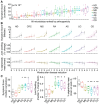This is a preprint.
Inflammatory disease microbiomes share a functional pathogenicity predicted by C-reactive protein
- PMID: 39868147
- PMCID: PMC11761010
- DOI: 10.1101/2025.01.14.633015
Inflammatory disease microbiomes share a functional pathogenicity predicted by C-reactive protein
Abstract
We examine disease-specific and cross-disease functions of the human gut microbiome by colonizing germ-free mice, at risk for inflammatory arthritis, colitis, or neuroinflammation, with over 100 human fecal microbiomes from subjects with rheumatoid arthritis, ankylosing spondylitis, multiple sclerosis, ulcerative colitis, Crohn's disease, or colorectal cancer. We find common inflammatory phenotypes driven by microbiomes from individuals with intestinal inflammation or inflammatory arthritis, as well as distinct functions specific to microbiomes from multiple sclerosis patients. Inflammatory disease in mice colonized with human microbiomes correlated with systemic inflammation, measured by C-reactive protein, in the human donors. These cross-disease patterns of human microbiome pathogenicity mirror features of the inflammatory diseases, including therapeutic targets and the presence or absence of systemic inflammation, suggesting shared and disease-specific mechanisms by which the microbiome is shaped and drives pathogenic inflammatory responses.
Conflict of interest statement
Competing interests: JJF is on the scientific advisory board of Vedanta Biosciences, reports receiving research grants from Janssen Pharmaceuticals, and reports receiving consulting fees from Innovation Pharmaceuticals, Janssen Pharmaceuticals, BiomX, and Vedanta Biosciences. AND and DG were employees of Janssen Research and Development LLC at the time of this work. SS and DG are current employees of Seed Health. DRL is a founder and adviser to Vedanta Biosciences. PB has received institutional research funding from Merck, Benevolent AI, GSK, Regeneron and Novartis. KR has received research grant support from Bristol Myers Squibb and personal fees for lecturing or consultancy activity from Abbvie and Sanofi. Other authors declare they have no competing interests.
Figures




References
-
- Dehghan A. et al. Risk of Type 2 Diabetes Attributable to C-Reactive Protein and Other Risk Factors. Diabetes Care 30, 2695–2699 (2007). - PubMed
-
- Thompson K. N. et al. Alterations in the gut microbiome implicate key taxa and metabolic pathways across inflammatory arthritis phenotypes. Science translational medicine 15, eabn4722 (2023). - PubMed
Publication types
Grants and funding
LinkOut - more resources
Full Text Sources
Research Materials
